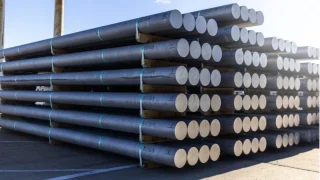
Aquifer groundwater is a crucial and valuable resource for Australia, but is poorly managed and monitored to the point of being neglected in some areas. This neglect is a risk for the future of Australia’s $60 billion agriculture production and industry that relies on the resource in an arid country.
About 30% of Australia’s total water consumption comes from groundwater, and use of the resource is increasing (estimated to have increased at least 90% — nearly doubled — in the 15 years from 1985-2000 alone).
About 70% of the groundwater extracted is used for agriculture, and accounts for about 30% of the overall water used for agriculture. There is also strong reliance on such water for household water and other uses, with the Northern Territory in particular relying on groundwater for 90% of its overall water requirements.
The volumes of water drawn far outstrip the estimated restocking from natural recharge, resulting in groundwater levels falling in many parts of Australia. However, it is impossible to accurately gauge how much the levels of groundwater resources have fallen, due to the poor monitoring of groundwater extraction, lack of proper management, underpricing of the resource, and lack of acknowledgement of its importance.
A renewed effort to audit and evaluate the current state of the monitoring system with recommendations for improvements to bring it up to an acceptable level is needed.
Groundwater monitoring and management: overview
It is impossible to accurately gauge how much the levels of the Great Artesian Basin (GAB) and other groundwater resources have fallen, due to the poor monitoring of water extraction, lack of proper management, underpricing of the resource, and lack of acknowledgement of its importance.
There have been significant efforts over the past 30 years to manage this resource but the focus has waxed and waned. There is no continuous national work programme to bring the system up to an acceptable standard.
This has come about because it is largely a state responsibility and states have not appropriately funded or maintained the management systems (largely monitoring bores and staff) to allow proper overview. The federal government has developed an integrated collection and reporting system (BoM) but this has faded in value due to the declining monitoring network which feeds it.
The Murray Darling Basin Authority has focused attention on some parts of the problem but its main job is to buy back environmental water via purchase plans and efficiency development. The audit should focus on areas that would evaluate costs and benefits from both commercial and environmental viewpoints. We need to maximise the amount of water that can be safely made available to agriculture while improving our knowledge of the sustainability to safeguard future generations and also protect the ecological values and ecosystem service provided by the aquifers.
Also read: Renewables offer economic development potential for Indigenous communities
SELECTED REFERENCES
Groundwater Use. https://www.ga.gov.au/scientific-topics/water/groundwater/basics/groundwater-use
Harrington N and Cook P, 2014, Groundwater in Australia, National Centre for Groundwater Research and Training, Australia.
Jakeman A.J, Barreteau O, Hunt R.J, Rinaudo J-D, Ross A, Arshad M, and Hamilton S. Integrated Groundwater Management (IGM) An Overview of Concepts and Challenges 2018
Water Use on Australian Farms https://www.abs.gov.au/statistics/industry/agriculture/water-use-australian-farms/latest-release (May 2020)
August 2025 update
Australia is still facing a growing water security crisis driven by over-extraction, climate-driven declines in aquifer recharge, and insufficient investment in groundwater monitoring and governance. While governments have made incremental improvements over the last five years, current systems remain inadequate to meet national sustainability goals. Without urgent investment and reform, Australia risks severe aquifer degradation, rising costs to agriculture and mining, town water shortages, and the collapse of critical groundwater-dependent ecosystems.
Key Issues
- Declining Recharge and Rising Demand
- Climate change has reduced rainfall and groundwater recharge across much of southern and western Australia.
- Groundwater is increasingly relied upon during droughts, especially by agriculture, mining, and inland towns.
- Projections show up to 20% growth in groundwater demand in agriculture and over 10% in mining by 2040.
- Incomplete Monitoring Networks
- Many monitoring bores are 30–60 years old and failing. Up to 50% may become inoperable without renewal.
- Key aquifers remain under-monitored, especially in remote agricultural and mining regions.
- Extraction data is patchy: many bores are unmetered, and usage is often self-reported with minimal auditing.
- Fragmented Governance and Weak Compliance
- Groundwater is managed state-by-state with inconsistent rules, data standards, and enforcement.
- Some state regulators (e.g. Western Australia) do not know whether licensed users are complying.
- Federal initiatives (e.g. Bureau of Meteorology’s national database) are limited by poor upstream data.
- Environmental Risks and Community Vulnerability
- Aquifer depletion has caused ecosystem decline, saline intrusion, and wetland collapse.
- Many regional towns depend entirely on groundwater and face growing supply risks.
- Without reform, Australia could face widespread groundwater stress within 10–20 years.
Recent Government Efforts (2020–2025)
Positive developments include:
- Federal investment in the National Groundwater Systems project and updated national modelling guidelines.
- State strategies (e.g. NSW Groundwater Strategy, WA Gnangara Allocation Plan) to reduce overuse.
- Expansion of telemetry-enabled monitoring bores in mining and agricultural regions.
- Updated allocation plans and commitments to improve metering and transparency.
However, these efforts remain insufficient:
- No national bore renewal program exists.
- Metering of groundwater extraction remains incomplete in most jurisdictions.
- Groundwater models in some regions are outdated or not public.
- Enforcement activity remains low, with many license breaches unpenalised.
Policy Recommendations
- Establish a National Groundwater Monitoring and Compliance Fund
- Co-funded by federal and state governments to replace aging bores and install meters.
- Mandate Real-Time Metering for All High-Use Bores
- Require telemetry for irrigation, industrial and mining bores above threshold volumes.
- Renew the National Water Initiative with Stronger Groundwater Provisions
- Set binding standards for groundwater data, extraction reporting, and aquifer modelling.
- Prioritise Managed Aquifer Recharge (MAR) and Demand Reduction Programs
- Fund large-scale MAR projects and water efficiency programs in dryland farming regions.
- Strengthen Interjurisdictional Governance for Shared Aquifers
- Implement basin-wide groundwater plans (e.g. for the GAB and Murray-Darling) with independent oversight.
Conclusion
Australia’s ability to manage groundwater is improving, but not fast enough. The risks are increasing faster than the reforms. Without strong national leadership, reliable data, and coordinated investment, Australia will likely face a wave of groundwater failures over the next two decades — with serious consequences for rural livelihoods, national food security, mining operations, and ecosystems. Water reform must put groundwater at the centre of national policy — or risk losing it.











